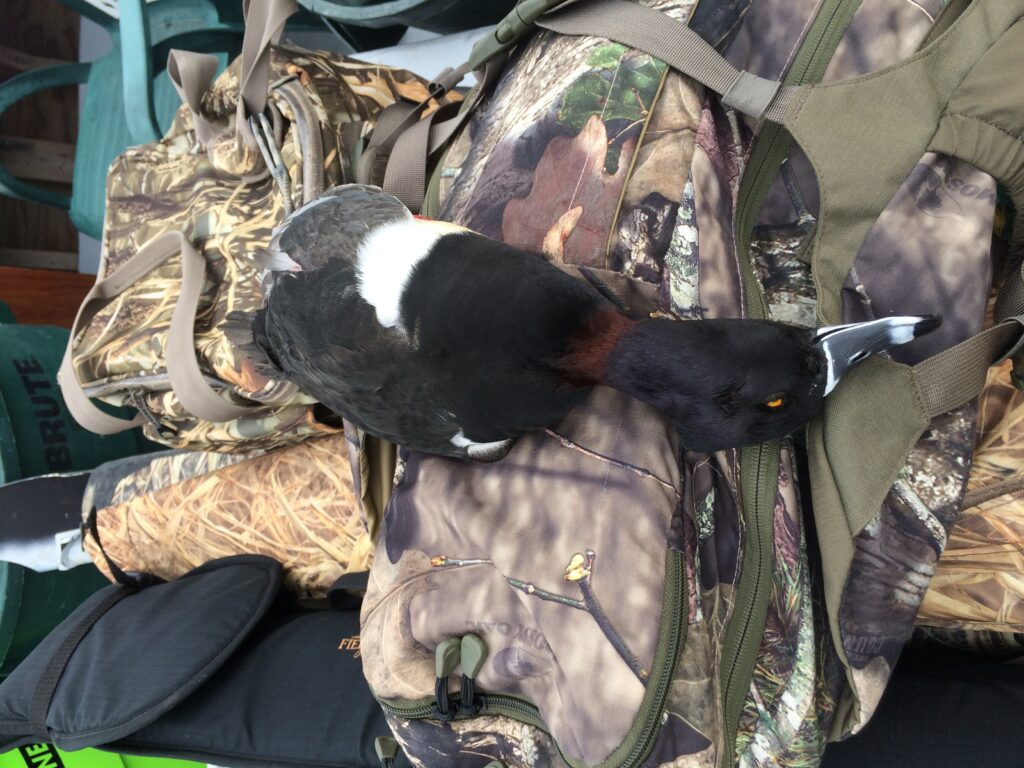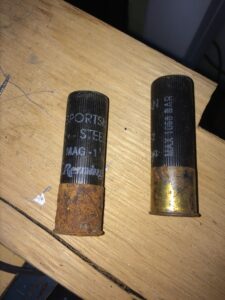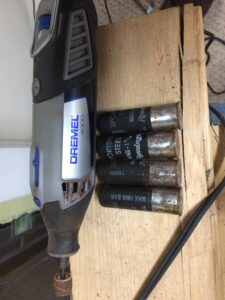January 29th, 2021
My friend called me and asked if I wanted to hunt ducks on the Eastern Shore of Maryland. Same general location that my son killed his first deer; a vicinity I have fished for many years. Several other guys would be along, all but one I already knew and liked. Sounded like a fine plan, and I signed up to share a hotel room with my friend and his son.
As the days went by my pile of preparatory hunting gear got bigger. Neoprene waders and boots, check. Huge and super warm waterfowling jacket with super old school camo pattern I bought at LL Bean decades ago, check. Shotgun in waterproof case, check. Wool long johns, wool shirts, scarves, bison wool hat, gloves and glove liners, warm boots, check check check.
Ammo. Right…hmmm…shotgun shells for the shotgun. What about the steel shot we have had to use since the 1990s ban on lead shot for waterfowling? Although I knew I had some already, I needed to get a good supply of that shot in twelve gauge, because ducks in general and sea ducks in particular are fast as hell and easy to miss. For every duck a hunter brings to hand, he might fire four or five shells. She might fire three or two, by the way.
So on an unrelated trip to that area several weeks ago, I checked Cabela’s in Hamburg, PA. I found a guy on his knees studying eight boxes of shotshells, and describing his find to someone on the other end of his cell phone. And I mean eight boxes total out of what had been a shelving system five feet high and forty feet long once filled with thousands of shotshells, and now containing a grand total of eight boxes of 25 shells each. And four were in 20 gauge, useless to sea duck hunters, who need the maximum power and shot load of a 12-gauge magnum.
So that left four boxes of 12-gauge #3 steel shot, which is OK for regular fresh water ducks but of limited use on sea ducks, which are bigger and tougher. And the guy kneeling down studying them was running his hand over the boxes, and describing them to some unseen prospective buyer chum.
“Tell your friend on the phone that if you don’t buy that 12-gauge right now, I am buying it,” said I to the guy studying the ammo.
“Buy it! Buy it!” came the cry on the other side of the cell phone.
And so I departed Cabela’s with only a flashlight and no steel shot. What the hell people are doing hoarding steel shot is beyond my ability to guess or even imagine. No civil wars will be won with steel shot. No home invaders repelled with steel shot. I don’t believe there are so many waterfowlers that every daggone shell produced is being used as we sit and read this.
And so it went at the other outdoor stores I visited, including mass retailer Bass Pro, where ammunition is usually sold by the truck load. Nothing, nicht, zero. Which then drove me past the retail approach and back into my ancient stashes of hunting ammunition. And indeed, I discovered a wide assortment of waterfowling ammunition accidentally stored in all kinds of odd and dubious places, like wader pockets, inside boots, PFDs, and in crumbling boxes moldering away in musty corners. But at the end of my search, I discovered in total about two boxes worth of steel shot, ranging from 2-3/4″ to 3-inch magnums to half a box of 3.5″ super magnums. Some of the shells needed help, though, before they could be fired in a gun.
And so a Dremel with heavy grit sandpaper was employed to remove heavy rust, and then a small wire brush at high RPMs to give a decent polish. Yeah, I was that desperate, but the work paid off. I was happy to have what I had.
I am pleased to report that the rusty old ammo garnered a healthy haul of ducks, which could be dubbed the rusty ducks.

A ring necked duck, an uncommon visitor to the Chesapeake Bay’s southern waters

Rusty old ammo, and happy to have it

Turning rusty old ammo into dubious but functional ammo that worked and got ducks

Sunrise off of Tilghman Island. What life is all about
By Josh • Posted in
Family •
No Comment
June 3rd, 2015
Since early childhood and Wyeth paintings of Captain Kidd and pirates bearing cutlasses and flintlock pistols, old timey guns and edged weapons have gripped my imagination.
No, there is no oddity here in that. There is no eccentric or weirdo behavior resulting from this affliction. In a sporting world increasingly enamored of stainless steel and plastic firearms, bearing Hubble Telescope-like magnifying scopes capable of coldly assassinating animals at half a mile or longer, being a nut for simple guns of old steel, open sights, and darkened walnut sets one apart more on the side of sanity.
When these old guns last hurt someone, the War of 1812 was a recent memory; maybe some time in the 1890s a kid playing with one hanging above the mantle managed to unintentionally bag his grandma in the living room.
In 1994, a pile of them were dumped into the trash by one of my neighbors in suburban Maryland, because they were “guns,” and therefore bad, apparently, despite each one being representative of one artistic school or another, each a canvas of steel and wood, not fabric. Together worth a new luxury car at that time, and today each worth a single car.
Dumping them in the trash was that recent widow’s own self-inflicted wound.
In general, these quality antique firearms and their “modern” descendants, including the black powder express rifles, double barrel shotguns, nitro double barreled rifles, and single-shot stalking rifles, pose no risk to humans and are a threat to four-legged animals only when used with hard-won, developed skill and hard-earned, focused woodcraft. After all, these weapons require their user to approach wary wild game within at least 150 yards, and well within 100 yards is preferred, where noses, ears and eyes easily tell the quarry “RUN! NOW! FAST!”
No assassinations here. Hunting skill is the key.
Many of these guns were made at a pivotal time in human and technological history when steels were dramatically improving in hardness and durability, explosives were well on their way to matching our best fireworks today, electricity-powered machinery was becoming more available and more precise, human labor was still abundant and relatively cheap, and standards of craftsmanship were still exceptionally high so that each item a worker produced carried his or her pride of best abilities applied.
Finally, remote stands of ancient walnut trees and other tree species, long neglected for their timber and enjoyed by the natives for their fruits and nuts, became known and available by steam locomotive, pack mule, and steam ship. Wood from these trees captured a time when few factors reared their hands against the relatively soft material, and so they grew slowly in peace and quiet in far-off lands and places, each decade adding a narrow band of dense and highly figured curl and figure to what would eventually become a stunning, valuable gunstock in London, Suhl, Ferlach, and Belgium.
Today, such firearms, and even reproductions of them, are highly sought after by harmless romantics seeking to hunt but not necessarily to kill, to capture the essence of bringing an aesthetically pleasing hand-craft to the necessary bloodletting in harvesting wild game; basically, to class-up and improve the joint a bit with style and understated elegance.
Certainly there are representations of this time period among our most favorite buildings around the planet, so if “guns” elude you, your emotions, or your tastes, think of beautiful, carefully constructed, famous buildings that inspire people (or furniture, or cars, or or or…). Then you should understand that those nerdy, harmless romantics actually carry such high art around in the woods, and that being a nut for such specimens of humankind’s best mechanical and artistic abilities is not such a strange preoccupation, after all.
It is an aesthetic pursuit, with a bang.
As this right here is not a book, and as it is merely my own small, off-hand, and brief attempt to say Thank You to people who have distantly but materially added to my quality and enjoyment of life, just three institutions are receiving mention today, though many many many more deserve kudos, too (Steve Bodio comes to mind, or Ironmen Antiques, and and and…).
First, a big thank you to the Cote Family, the hard working founding publishers of the Double Gun & Single Shot Journal (DGJ), 1989 to present. Without the DGJ, aficionados of old but not the oldest or most popular firearms would have but occasional and fleeting mentions in Grey’s Sporting Journal, American Rifleman, and hard-to-find tomes filled with errata and alchemy. DGJ captures both the spirit of old hunting tools and methods, and the details required to make the whole endeavor successfully fall into place now.
Without the DGJ, Capstick and Pondoro and similar oldies-but-goodies would be most of the reading available to us. Yes, yes, Roosevelt’s African Game Trails and his other hunting books are phenomenal, but how many times over can a person read them?
So a huge Thank You to the Cote family for keeping the DGJ going.
Second, DGJ hosts such gifted analysts as Sherman Bell, whose decades-long “Finding Out for Myself” series of articles has put to rest silly notions about using black powder and nitro-for-black substitutes (yes, you can kill a beautiful buck with style, elegance, and woodcraft, you do not have to be an assassin to be successful), the safety of Damascus barrels (yes, they are safe with modern shells), and other interesting myths and facts surrounding Grandpa’s old gun on the mantle. Thank You to Sherman Bell, for enriching my life in small but directly meaningful ways with these beloved and useful artifacts.
Finally, a huge Thank You to noted gun writer Ross Seyfried, whose introspective writings and wanderings in DGJ and elsewhere have inspired many others to pick up the double rifle or single shot, and shelve the plastic contraption, once again capturing the spirit, at least, of fair chase. And Thank You, Ross, for your own steady, incredibly patient guidance and knowledge as I walk my own path.
Yes, I know, you too had your mentors, and they too held your hand and guided you along your path. We have walked those paths with you in the Matabeleland of Rhodesia/Zimbabwe and the hills of Elk Song in Oregon. But in a culture of increasingly shallow or fragile relationships, expectations of immediate gratification, point-and-click ‘knowledge’, plastic contraption guns, brief patience, half-mile assassinations of unstalked animals, and so on, being a junior apprentice to someone like you is a pleasurable rarity, and an honor.
Ross, I pledge I will do my best to follow in your footsteps and do as you have done with me: Passing along all of my knowledge of the old things, the old ways, the class and the grace — what little I possess!, to those who want them. I will withhold nothing from that next generation.
February 6th, 2014
Knife production is reaching an apex, it appears. Never before in one place have I seen so many higher quality production knives as I have seen at the Great American Outdoor Show. Many booths selling hundreds and hundreds of better quality folding knives, with some custom and semi-custom knife sellers sprinkled around.
Oddly, you can’t find a sharpening stone in the entire Farm Show complex to save your blade’s life. No one is selling sharpening stones. Blades out the wazoo, yes. Ways to keep them functioning, no. Whether it is a sign of the throw-away society meeting Pleistocene Man, or too much optimism about modern steels’ edge retention capability, it is an odd sign indeed.
Once the purview of expensive custom knives, Damascus blades are now ubiquitous, although most are probably made in Pakistan and India, so their quality cannot be real high, and you’ve got no idea of their cadmium, arsenic, or lead content, either, although I am willing to bet these blades are positively toxic to human health. They do look nice, though.
[Damascus steel is a mix of different types of metals that when folded over and over and then hammered out reveal an appealing variety of patterns. Because metal types used in Damascus steel vary widely, quality varies widely. I use only Alabama Damascus in my knives]
Clearly, there is a bleeding over from the custom knife market into the high production market, where quality used to suffer badly. Knife buying Americans evidently have improved tastes and higher expectations for their over-the-counter knives. That’s a good thing. But do they have to be made in those rainbow colors? They hurt my eyes. Camo handles are humorous – drop your knife, never find your knife, lose your knife. Maybe those rainbow colored handles work, after all.
One other observation is the high number of bug-out bags being made. Man, Americans seem ready for the apocalypse. After seeing so many of these grab-and-run packs, I now realize that I need one, too. No, my oh-so-1970s Kelty backpacks do not seem up to snuff, even though they have served me well on rugged wilderness trips for many years. Nope, camo is de rigeur here, too.
Come on by the PA Federation of Sportsmen’s Clubs booth and buy a raffle ticket for our Bushmaster AR-15 M4. Just ten bucks gets you a lot closer to having your bug-out bag fully equipped with a state-of-the-art rifle.
By Josh • Posted in
Family •
No Comment



